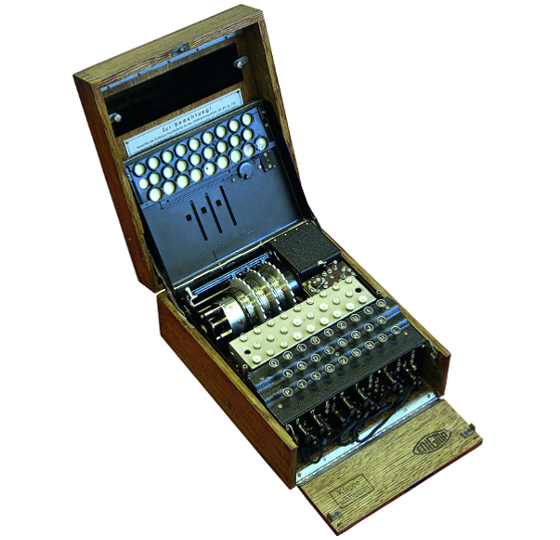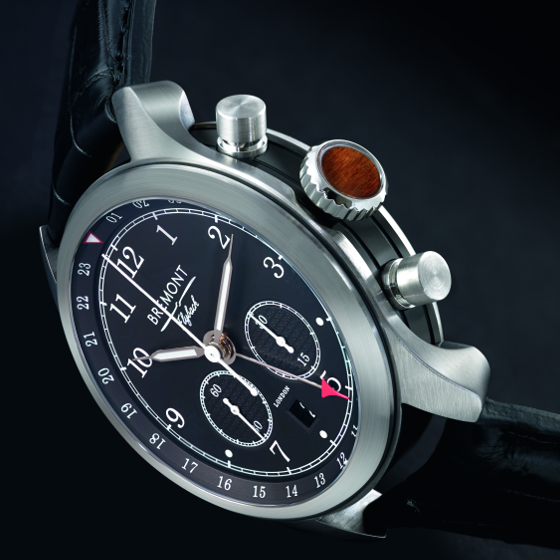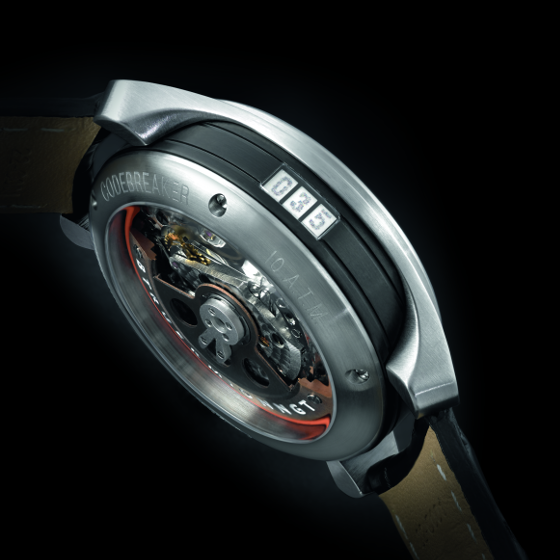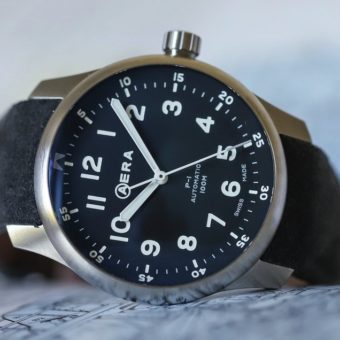Bremont has carved out a niche for itself by weaving bits of historical DNA, usually British, into the fabric of selected timepieces. The EP120 and P-51 limited editions incorporated parts from famous WWII fighters. The Victory featured fragments of oak timber and copper from Admiral Nelson’s flagship at the Battle of Trafalgar. We test the Bremont Codebreaker, which incorporates three genuine artifacts from one of the most exciting chapters in WWII history.
The Codebreaker, a limited edition of 240 pieces, pays tribute to Bletchley Park – an estate in the English countryside that served as the center for British code-breaking operations. It was there that Alan Turing and other luminaries designed early computers to break the complex codes created by the German Enigma and Lorenz machines.

Bremont says the Codebreaker’s design is inspired by classic 1940s officers’ watches. It’s a GMT flyback chronograph with subdials located “south of the border,” so you know there’s something a bit out of the ordinary under the hood.
The first thing that grabs your eye when you look at the dial is the bright red, arrow-shaped tip that tracks the second time zone on a 24-hour index at the edge of the dial. Everything else is black or white. The continuous seconds are indicated on the register at 8 o’clock, and the 30-minute chronograph totalizer appears at 4 o’clock. The slightly oversized date is at 6 o’clock. We appreciate Bremont’s decision to replace the “4” and the “8” on the dial with small dots, avoiding digits partially consumed by the subdials. Speaking of the subdials, they are decorated with a subtle, raised “101010” binary-code motif. This is the only Bletchley Park connection visible when you look at the watch straight on.

Daytime legibility is excellent. All of the hands reach their respective tracks. The white hands and the red arrow tip provide excellent contrast against the matte black dial. During our test, the luminous material was not extremely bright at any point, though to eyes well adjusted to the dark it remained visible for 18 hours.

The case and bezel are stainless steel, though the color looks more like titanium. We measured the case at 42.4 mm in diameter and 17 mm thick, including the domed, nonreflective sapphire crystal. The lugs are a bit short, and the case is fairly thick. As a result, the watch tends to sit high on the wrist rather than hugging it.
The case and lugs have a complex shape. A black DLC ring with parallel grooves circles the case band, running behind the lugs. The lugs have a sculptural shape unlike anything we have seen before. The case has a fine, brushed finish, though that finish does not extend into the space between the lugs.
The first true Bletchley Park artifact is found on the 9 o’clock side of the case. The limited-edition number is set into the black band, and the digits are cut from actual punch cards that were used in the code-breaking efforts. A small crystal covers the number, and Bremont assures us that the rare digits are protected against water. Note, however, that if you submerge the watch, you should not use the chronograph under water.
Across the dial, the second Bletchley Park memento is affixed to the crown. It’s a round piece of pine wood from the floor of Hut 6 in the Bletchley Park complex. Originally constructed as temporary office buildings, the huts housed various code-breaking operations. Hut 6 has been described as the “nerve center” of the Enigma decoding effort.

The crown and push-pieces are easily accessed, thanks to the lack of crown guards. The crown is very easy to use. In the first setting position, a clockwise turn adjusts the date, while counterclockwise sets the GMT hand. The second setting position adjusts the time, and a stop-seconds mechanism makes precise setting a breeze.
The chronograph starts with a light push, and stops with a bit more pressure. Both actions are smooth, and a faint yet crisp click confirms each input. The chronograph seconds hand starts smoothly, but when running it exhibits a bit of the stutter often associated with 7750-based movements, though it’s not as pronounced as we have seen in other watches with this base caliber. All hands reset precisely to zero, and the flyback function works precisely.
The Codebreaker’s 22-mm black crocodile strap is well padded and generously long at 122/77 mm. Curved spring bars secure it to the lugs. The milled pin buckle is decorated with an engraved Bremont logo. Like the space between the lugs, the inner buckle surfaces are less well finished than those visible to the world. The Codebreaker is also delivered with an attractive calfskin NATO strap.

When you turn the watch over, an expansive, slightly domed display window reveals the movement, and the final Bletchley Park artifact is front and center. The Codebreaker’s rotor design is inspired by the Bombe machine, used to decrypt Enigma-encoded messages. The winding rotor incorporates a machine-worked part from an original Enigma-machine rotor wheel. The Codebreaker’s rotor is engraved with a lightly encrypted message. (Hint: look for two proper nouns, one of which appears on the dial.)

The movement itself bears caliber number BE-83AR. That is the same caliber number borne by the movement in Bremont’s Victory timepiece, though the movements are clearly dissimilar. Bremont told us the calibers bear the same number because each uses the same ETA base, though each watch has a distinctive and bespoke complication module. The Codebreaker’s movement was built to Bremont’s specifications by La Joux-Perret, and it is exclusive to Bremont. The movement runs in 39 jewels at 28,800 vph. The single barrel provides a 42-hour power reserve.
On close inspection, the movement is of typical, mid-tier quality. Plated perlage improves the aesthetics, though there are no polished surfaces, anglage, or other signs of fine hand finishing. In our test watch, the tip of the “rabbit ear” appeared to have been accidentally ground or filed down slightly.
The movement is surrounded by an orange Bakelite spacer. Bremont says the color and material replicate those used in Turing’s Bombe machines. The Bombe’s rotors had very distinctive colors – red, green, yellow and orange.
The Codebreaker performed very well on the Witschi machine. The greatest deviation of rate was 4 seconds both with the chronograph off and with it on. The average deviations were +4.2 seconds and 0 seconds, respectively. On the wrist, the Codebreaker ran +1 second over 24 hours with the chronograph off. The movement is not COSC certified, but it ran well within COSC specs, and Bremont told us that the same level of performance is expected in all Codebreaker movements.
Last but not least, this is a rare instance in which the packaging deserves special mention. Each watch is delivered in a handsome leather pouch. In addition to the watch, the pouch holds two notebooks with faux-aged covers. One is the warranty and the other is the owner’s manual. Each looks as though it was typed on a WWII-era Underwood. The pouch also holds the leather NATO strap, two pencils, a strap-changing tool, and a Zippo lighter embossed with the “Bremont Codebreaker” name. The packaging is an original and thoughtful addition to this Bletchley Park tribute.

At the end of the day, your interest in the Codebreaker, and your opinion about whether it offers good value, will depend almost entirely on your interest in Bletchley Park and the events that transpired there during the 1940s. The uninterested are likely to view this watch as an overpriced novelty. The interested will view it as a chance to own a piece of history (or three), and to support a good cause, as Bremont is donating a portion of the sales proceeds to support the ongoing restoration at Bletchley Park. These differing views on the question of value make the Codebreaker itself something of an enigma.

train lines connecting Oxford, Cambridge and London.
SPECS:
Manufacturer: Bremont Watch Co. P.O. Box 4741, Henley-on-Thames, Oxfordshire, RG9 9BZ, U.K.
Reference: Codebreaker SS
Functions: Hours, minutes, small seconds, date, chronograph with flyback function and 30-minute counter, second time zone
Movement: Caliber BE-83AR (ETA 7750 base), 157 parts, automatic, 28,800 vph, 39 jewels, Incabloc shock absorption, Glucydur balance, Nivarox 1 balance spring, Etachron fine adjustment, 42-hour power reserve, diameter = 29.9 mm, height = 7.9 mm
Case: Stainless steel, domed sapphire crystal with nonreflective coating on both sides, screw-down caseback with domed sapphire crystal without nonreflective coating, lug width = 22 mm, water resistant to 100 m
Strap and clasp: Padded black crocodile strap with machined stainless-steel pin buckle. Also supplied with a calfskin NATO-style strap
Rate results (Deviation in seconds per 24 hours, with chronograph switched off/on):
Dial up +6 / 0
Dial down +6 / +2
Crown up +4 / -2
Crown down +5 / +2
Crown left +2 / -2
Crown right +2 / -1
Greatest deviation of rate 4 / 4
Average deviation +4 / 0
Average amplitude:
Flat positions 302° / 274°
Hanging positions 273° / 264°
Dimensions: Diameter = 42.4 mm, height = 17 mm, weight = 120 g
Variations: Rose gold (limited edition of 50 pieces, Reference Codebreaker RG, $33,995)
Price: $18,500
Limited edition of 240 pieces
Timing tests performed by Wempe Jewelers, New York City
SCORES:
Strap and clasp (max. 10 points): The standard two-piece strap fitted to our watch is of good but not excellent quality, though the length is generous. Some might expect more than a pin buckle on a steel watch priced at $18,500, but that is likely the most comfortable option. 7
Operation (5): The crown and push-pieces offer a good feel and precise functioning, though the chronograph seconds hand is not entirely smooth. The flyback function works well. A stop-seconds feature simplifies precise setting. 4
Case (10): The black DLC case band and complex lugs make this case unique. At this price, we would prefer to see the fine brushed finish applied between the lugs. 7
Design (15): The design defies easy categorization. It has a vintage military air, but few pieces from that era offered these complications, not to mention subdials located below the center of the dial. 12
Legibility (5): Clear, high-contrast displays offer good legibility day and night. 4
Wearing comfort (10): The thick case and short lugs mean the watch sits a bit high on the wrist. 8
Movement (20): A tried-and-true third-party base movement with a bespoke and exclusive complication module. The function is good, though the finish is industrial. 13
Rate results (10): Very good results on the Witschi with only a 4-second maximum variation in rate. Excellent real-world performance at +1 second per day on the wrist 9
Overall value (15): The value calculation depends entirely on one’s desire to own a piece of WWII history and to support the associated cause. We assume that anyone who considers purchasing this watch will value the history highly, and from that perspective, the value is good. 12
TOTAL: 76 POINTS
This article first appeared in the August 2014 edition of WatchTime Magazine. Photos are by Robert Atkinson.






